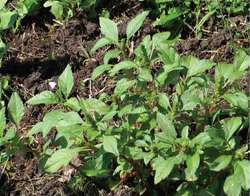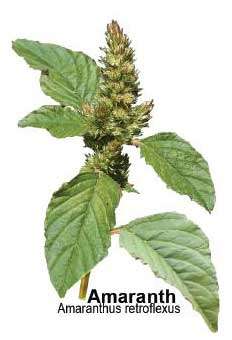Biological control of pigweeds (
Amaranthus retroflexus L., A.
Niche partitioning between two phosphoglucoisomerase genotypes in
Amaranthus retroflexus. Ecology 65:218-222.
House (1989) demonstrated that predatory soil arthropods were abundant in the root systems of dogfennel, Eupatorium capillifolium (Lam.) Small, and rough pigweed,
Amaranthus retroflexus L., present in experimental corn and soybean plantings.
(1982) found that total phenolic content of Helianthus annuus increased with increased nutrient stress, and thus had significant inhibitory effects on seed germination of
Amaranthus retroflexus. Stowe and Osborn (1980) found that phenolic allelochemicals were more inhibitory at low nutrient concentrations.
Os tratamentos testados seguiram o esquema fatorial 2 x 5, sendo os fatores a combinacao de duas cultivares de oliveira, 'Arbequina' e 'Ascolano', quatro especies de plantas competidoras,
Amaranthus retroflexus, Brachiaria brizantha, Bidens pilosa, Cenchrus echlnatus e um tratamento testemunha (sem competicao).
Adding nitrogen from 40 to 240 ppm increased the biomass of many weed species like wild mustard, Sinapis arvensis, and redroot pigweed,
Amaranthus retroflexus, more than wheat and canola.
Redroot pigweed (
Amaranthus retroflexus L.) and common lambsquarters (Chenopodium album L.) were not found at the low N rate, but had similar densities of 0.4 and 4.7 plants [m.sup.-2] in the medium and high N rates.
Similarly, genetic diversity for phosphoglucoisomerase is apparently maintained in populations of
Amaranthus retroflexus by the conjunction of crossing norms of reaction and within-site soil moisture variation (Zangerl and Bazzaz 1984).
The primary weeds at the Nebraska site were redroot pig-weed (
Amaranthus retroflexus L.), large crabgrass [Digitaria sanguinalis (L.) Scop.], prostrate spurge [Euphorbia (supina Raf.
Response of corn at leaf stages to shading by redroot pigweed (
Amaranthus retroflexus L.).

